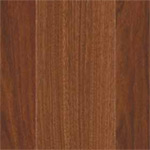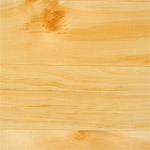|
| |
 |
Types
of Wood
Wood is generally categorized into two groups:
hardwood and softwood. Hardwood comes from deciduous trees, which have broad leaves that shed during a certain season of the year. Softwood comes from coniferous, or cone-bearing, trees with narrow leaves or needles that remain on the tree year-round. Most quality furniture uses hardwood in either solid or veneer form as a primary wood; a softwood is used as a secondary wood for the inside of cabinets, drawer sides, backs or bottoms.
|
| Hardwoods
|
 Birch.
In its natural state birch appears white or creamy yellow to light brown with a tinge of red. Often, birch is stained to match other kinds of wood in furniture. Much of the clear, cabinet-grade plywood is produced from birch, which takes stain nicely and finishes well. In addition, birch is often chosen to make interior doors and cupboards. Birch.
In its natural state birch appears white or creamy yellow to light brown with a tinge of red. Often, birch is stained to match other kinds of wood in furniture. Much of the clear, cabinet-grade plywood is produced from birch, which takes stain nicely and finishes well. In addition, birch is often chosen to make interior doors and cupboards.
|
 Cherry.
American black cherry is a popular furniture hardwood. Cherry is a light reddish brown to brown color, which deepens into rich color as it ages. Cherry has a closed grain and is softer than other hardwoods. Much cherry lumber is narrow.
[$$ - increases price by approximately 35%] Cherry.
American black cherry is a popular furniture hardwood. Cherry is a light reddish brown to brown color, which deepens into rich color as it ages. Cherry has a closed grain and is softer than other hardwoods. Much cherry lumber is narrow.
[$$ - increases price by approximately 35%]
|
 Mahogany.
Mahogany is a strong, relatively hard wood that works and finishes well. It is also used for decorative woodwork and was widely used in shipbuilding. Mahogany falls into three basic categories: American mahogany, African mahogany and Honduran mahogany. In mahogany's natural state the open-grain wood has a light pink to reddish brown color with a fine texture. In addition to straight grain, mahogany can have interesting patterns, including the crotch grain pattern often used a veneer face for cabinet doors and drawers. You can find mahogany finished in various tones of red, and beautiful brown and golden tones.
[$$ - increases price by approximately 35%] Mahogany.
Mahogany is a strong, relatively hard wood that works and finishes well. It is also used for decorative woodwork and was widely used in shipbuilding. Mahogany falls into three basic categories: American mahogany, African mahogany and Honduran mahogany. In mahogany's natural state the open-grain wood has a light pink to reddish brown color with a fine texture. In addition to straight grain, mahogany can have interesting patterns, including the crotch grain pattern often used a veneer face for cabinet doors and drawers. You can find mahogany finished in various tones of red, and beautiful brown and golden tones.
[$$ - increases price by approximately 35%]
|
 Maple.
Maple is an exceptionally hard, dense, close-grained wood. In its natural state the wood has a white or off-white to amber color. The grain is tight and subtle, except in the case of burl, curly,
fiddleback, and bird's-eye maple. These grain patterns offer a variety of interesting, beautiful configurations and are often used for decorative purposes. Because it's so dense, maple is heavier than most other hardwoods. Maple.
Maple is an exceptionally hard, dense, close-grained wood. In its natural state the wood has a white or off-white to amber color. The grain is tight and subtle, except in the case of burl, curly,
fiddleback, and bird's-eye maple. These grain patterns offer a variety of interesting, beautiful configurations and are often used for decorative purposes. Because it's so dense, maple is heavier than most other hardwoods.
|
 Oak.
Common varieties of oak used in furniture include white oak, red oak, and English, or brown, oak. Oak has a pronounced open grain with a rough texture. It is quite hard, sometimes making it difficult to work. White oak has a slightly gray-brown color. Red oak is similar except that it has a reddish brown tinge. English oak tends to be a deeper brown color. Oak.
Common varieties of oak used in furniture include white oak, red oak, and English, or brown, oak. Oak has a pronounced open grain with a rough texture. It is quite hard, sometimes making it difficult to work. White oak has a slightly gray-brown color. Red oak is similar except that it has a reddish brown tinge. English oak tends to be a deeper brown color.
|
 Poplar.
Another hardwood, poplar has a straight, even, closed grain, but it is fairly soft, making it easy to work. Poplar is white or yellow, sometimes with a green caste and an occasional dark streak running through it. It is widely used as a secondary wood for the insides of cabinets, chests and drawers. Poplar.
Another hardwood, poplar has a straight, even, closed grain, but it is fairly soft, making it easy to work. Poplar is white or yellow, sometimes with a green caste and an occasional dark streak running through it. It is widely used as a secondary wood for the insides of cabinets, chests and drawers.
|
 Rosewood.
Rosewood is a distinctive-looking hardwood. The wood is naturally brown or reddish brown with dark or ebony grain figuring, but it can sometimes have a creamy color in it. Because of its hardness and density, rosewood can easily be finished to a high luster. Rosewood is resistant to shrinking and is often used in musical instruments like pianos or guitars. Rosewood.
Rosewood is a distinctive-looking hardwood. The wood is naturally brown or reddish brown with dark or ebony grain figuring, but it can sometimes have a creamy color in it. Because of its hardness and density, rosewood can easily be finished to a high luster. Rosewood is resistant to shrinking and is often used in musical instruments like pianos or guitars.
|
 Teak.
This naturally oily wood is a yellowish brown open-grain hardwood that is popular for both interior and exterior woodwork, especially on boats. Teak will usually have a rubbed oil finish when found in furniture. Teak.
This naturally oily wood is a yellowish brown open-grain hardwood that is popular for both interior and exterior woodwork, especially on boats. Teak will usually have a rubbed oil finish when found in furniture.
|
 Walnut. American black walnut is used extensively in furniture. The wood has a gray to chocolate-brown color, sometimes with purple streaks or light-colored sapwood on the edges of its boards. Walnut works well in furniture building and can be finished in warm wood tones. Walnut usually has interesting and beautiful grain patterns ranging from straight grain to swirl patters to distinctive burl grains, depending on the cut of the wood. European walnut is scarce and more expensive than American black walnut. You'll find this wood most often in veneer form. While European walnut lightens with age, American walnut becomes darker.
[$ - increases price by approximately 20%] Walnut. American black walnut is used extensively in furniture. The wood has a gray to chocolate-brown color, sometimes with purple streaks or light-colored sapwood on the edges of its boards. Walnut works well in furniture building and can be finished in warm wood tones. Walnut usually has interesting and beautiful grain patterns ranging from straight grain to swirl patters to distinctive burl grains, depending on the cut of the wood. European walnut is scarce and more expensive than American black walnut. You'll find this wood most often in veneer form. While European walnut lightens with age, American walnut becomes darker.
[$ - increases price by approximately 20%]
|
|
| Softwoods |
 Pine.
Pine may appear to have either a white cream to tan color or a yellow color with a brown grain figure. You'll also see knotty pine, known for prominent and abundant knots in its boards. Pine has a tendency to accept liquid wood stain unevenly and may produce a blotchy appearance. Pine.
Pine may appear to have either a white cream to tan color or a yellow color with a brown grain figure. You'll also see knotty pine, known for prominent and abundant knots in its boards. Pine has a tendency to accept liquid wood stain unevenly and may produce a blotchy appearance.
|
 Cedar.
Because it has an aroma that is disagreeable to insects such as moths, cedar is commonly used to line chests and closets used for garment storage. Cedar is a pink-to-brown close-grained wood used for exterior as well as interior woodwork, owing to its resistance to decay. Cedar.
Because it has an aroma that is disagreeable to insects such as moths, cedar is commonly used to line chests and closets used for garment storage. Cedar is a pink-to-brown close-grained wood used for exterior as well as interior woodwork, owing to its resistance to decay.
|
 Redwood.
Like cedar, redwood is also used for exterior work because of its resistance to decay and insect infestation. This natural wood is red in color. Manufacturers use it to produce exterior furniture, such as picnic tables or deck furniture Redwood.
Like cedar, redwood is also used for exterior work because of its resistance to decay and insect infestation. This natural wood is red in color. Manufacturers use it to produce exterior furniture, such as picnic tables or deck furniture
|
|
|